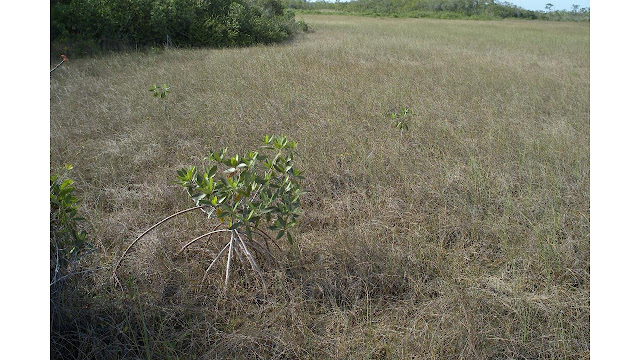The Everglades is a water world, and it relys on rain to operate the ecosystem. Note the graph below, from the visitor center, which shows how winter and spring are a time of drought, and summer is the wet season.
This picture is for the folks that took my water resources class. It shows saltwater intrusion, and the interplay of the fresh and salt water underneath southern Florida.
This sign shows the increase in population, but also the the water usage. The US average domestic water consumption is about 100 gallons a day (a little less in New England). So, the 200 used here is quite high, especially for a region that is water challenged. Here in the campground, there doesn't seem to be any consideration for resource conservation.
These pictures show the historic extent of the Everglades, and how it currently looks, with agriculture and urban development taking up about 2/3 of what was Everglades.
This picture shows folks enjoying and learning about the Everglades in the National Park.
This is a Cardinal Air Plant,or Tillandsia , one of the epiphytes you've seen in earlier blogs. This one is interesting to me, because we have a tiny one in the green house. Here, they grow like weeds.
In this picture of the plant blooming, you can see why its called the Cardinal Air Plant.
It amazes me to see how many epiphytes are on the trees here. I imagine the trees would like to just shake like a dog, and get some of those free-loaders off. However, the epiphytes don't take any resources from the trees, they just use the tree as a place to (literally) hangout.
This is a very uncommon tree, found only in the southern most areas. It's a mahogany tree. Maybe you have some mahogany furniture, or a Martin Mahogany guitar like I do. As you can see, this huge tree is also loaded with epiphytes. You mostly only find these in more tropical regions.
This is a cool shot of a nurse log. A nurse log is one that dies, and then serves as a host to other plants that are depended on it for habitat, nutrients, and the like. Some of these plants will use the nutrients stored in the tree, and eventually, even after the tree is long gone. The plant community will still be in the place where the log was. So, these nurse logs can make long-term changes in community composition.
My apologies for this shot. This is a manatee. For a critter as big as they are, they sure can get under water faster than I click the shutter.
Picture looking out at Flamingo Bay.
This shows how the wind is causing turbulence on this bay.
The Everglades, a river of grass. Those dark high islands are the hammocks of trees.
Better view of the boundary between the two ecosystems of grassland and hammock.
At the bottom of the food web, is periphyton, or mats of algae, cyanobacteria, and microbes. The shape, size, and coloration varies widely depending on how wet an area is. Besides being a food source, periphyton also acts like a sponge to create moist areas for animals to survive the dry season. My sciencey side says cool, the rest of me says "yuck."
A typical mangrove here. The mangroves here seem to all be stumpy little guys, not at all like the big ones we saw in Costa Rica. I'm not entirely sure why.
This was really interesting to me. This picture shows the edge of a hammock, where the tree island meets the grass. Recall that the geology of the area is limestone. When leaves fall off these trees, the tannic acid caused by the leaf decay causes the water to be slightly acidic, which dissolves the limestone around the hammock making something called a hammock moat. This is ring of deeper water surrounds the hammock.
Here's another view of a hammock moat. The hammock is on the right, then the deep wet moat, then the dryer grassland to the left.
This close up of a small sink hole in the limestone shows how the acidic water dissolves the rock.
These are bald cypresses, like you saw in the post for Colleton State Park a week ago. These are tiny, but they are full grown for this area. I've seen these up in the SC swamps as big as three feet in diameter. Probably the largest here is five inches in diameter.
Grassland with tree hammock to the distant right.
Saw this ressurection fern, which reminded me of the post from Tomoka State Park in the rain. Here, you can see what the fern looks like when its dryed up.



























No comments:
Post a Comment